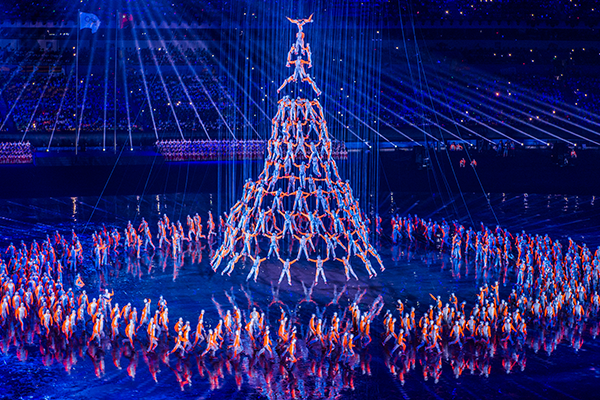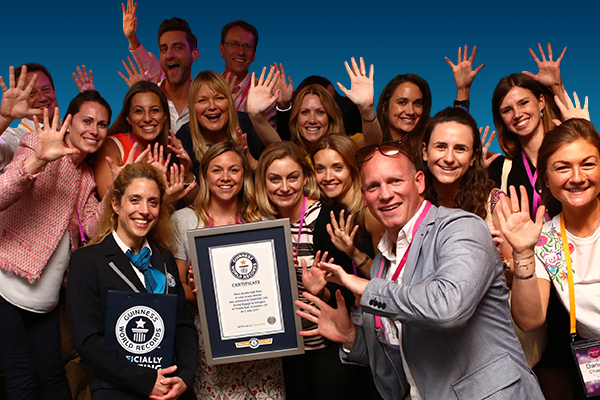Guide to impairment classifications
Guinness World Records believes in inclusiveness - and to us that means offering record-breaking for everyone, everywhere. To ensure we can offer record-breaking for challengers with physical, visual and intellectual impairments, a set of classifications have been created for sport, strength and journey records. These classifications allow for competitive records to be created and monitored which we believe puts challengers on a level playing field.
Here’s which type of records we’d consider for the classifications:
- Sport: Gym based exercises such as push ups, pull ups and squats; treadmill, static cycling and indoor rowing; sports skills such as soccer ball touches or basketball free-throws; running, cycling, swimming, handcycling, wheelchair racing, tricycle records; martial arts strikes; and many more.
- Strength: lifting and pulling weights; breaking blocks; vehicle pulls; strongperson events; and many more.
- Journeys: Traveling from place to place; circumnavigation; greatest distances travelled; most locations visited in a time frame; and many more.
If you’re interested in attempting a sport, strength or journey record which incorporates a classification please tell us in your application which of the following classifications is best suited for your impairment. To apply follow these steps:
To apply follow these steps:
- Login or Register an account if you don't have one.
- Once registered you can then search through our database for record inspiration or to find the record you wish to apply for.
- If you can’t find the record title with the classification you’re interested in attempting you may need to apply for a new record title
- When applying for a new record title it’s worth checking what we can monitor, so you can read about the criteria of what makes a Guinness World Records title here
- Once you’ve submitted your application our expert records management team will assess your proposal and issue guidelines if your application is accepted.
Our offering of classifications is set to grow over time and they’re constantly evolving. If you’re unsure which classification is best suited please consult with a medical professional before making your application. If you have an impairment not covered by our classifications please get in touch.
Classification terms and definitions
Unilateral above knee amputation (LA1)
For the purpose of this record a unilateral above knee amputation is the absence of the challengers leg from above or through the knee joint. Unilateral refers to a single leg.
Unilateral below knee amputation (LA2)
For the purpose of this record a unilateral below knee amputation is the absence of the lower leg; the knee joint must be present, but the ankle joint must not be present. Unilateral refers to a single leg.
Bilateral above knee amputation (LA3)
For the purpose of this record a bilateral above knee amputation is the absence of both the challengers legs from above or through the knee joint. Bilateral refers to both legs.
Bilateral below knee amputation (LA4)
For the purpose of this record a bilateral below the knee amputation is the absence of both the challengers lower legs; the knee joints must be present, but the ankle joint must not be present. Bilateral refers to both legs.
Unilateral above elbow amputation (AA1)
For the purpose of this record a unilateral above elbow amputation is the absence of a single arm from above the elbow joint or through the shoulder joint; the elbow joint must not be present. Unilateral refers to a single arm.
Unilateral below elbow amputation (AA2)
For the purpose of this record a unilateral below elbow amputation is the absence of a single arm from below the elbow; the elbow joint must be present, but the wrist joint must not. Unilateral refers to a single arm.
Bilateral above elbow amputation (AA3)
For the purpose of this record a bilateral above elbow amputation is the absence of both the participants arms from above the elbow joint or through the shoulder joint; the elbow joint must not be present. Bilateral refers to both arms.
Bilateral below elbow amputation (AA4)
For the purpose of this record a bilateral below elbow amputation is the absence of both the participants arms from below the elbow; the elbow joints must be present, but the wrist joints must not. Bilateral refers to both arms.
Impaired sight 1 (IS1)
For the purpose of this record classification participants must have a visual acuity range from (and including) LogMAR 0.5 to 1.48; and/or visual field constricted to a diameter of less than 40 degrees. Simulation goggles or blindfolds are not permitted to be worn during attempts, any protective eyewear is optional.
Impaired sight 2 (IS2)
For the purpose of this record classification participants must have a visual acuity range from (and including) LogMAR 1.5 to 2.58. Simulation goggles or blindfolds are not permitted to be worn during attempts, any protective eyewear is optional.
Impaired sight 3 (IS3)
For the purpose of this record classification participants must have a visual acuity over LogMAR 2.60. Simulation goggles or blindfolds are not permitted to be worn during attempts, any protective eyewear is optional.
Impaired sight 4 (IS4)
For the purpose of this record classification participants must have their visual field constricted to a diameter of less than 10 degrees. Simulation goggles or blindfolds are not permitted to be worn during attempts, any protective eyewear is optional.
Impaired hearing 1 (IH1)
For the purposes of this record hearing impairment refers to individuals who have hearing loss between 40- 54 db in their best ear. This must be confirmed by an audiogram (3 FAHL) confirmed by an audiologist.
Impaired hearing 2 (IH2)
For the purposes of this record hearing impairment refers to individuals with hearing loss beyond 55 db in their best ear. This must be confirmed by an audiogram (3 FAHL) confirmed by an audiologist.
Impaired hearing 1 single ear (IH1SE)
For the purposes of this record hearing impairment refers to individuals who have hearing loss in a single ear between 40-54 db. This must be confirmed by an audiogram (3 FAHL) confirmed by an audiologist.
Impaired hearing 2 single ear (IH2SE)
For the purposes of this record hearing impairment refers to individuals who have hearing loss in a single ear beyond 55 db. This must be confirmed by an audiogram (3 FAHL) confirmed by an audiologist.
Short stature (SS)
For the purpose of this record short stature refers to participants over the age of 18 who are less than 4 ft 10 in (147.32 cm).
Coordination impairment – quadriplegic (CI1)
For the purpose of this record coordination impairment - quadriplegic refers to the loss or lack of smooth body movements in all four limbs (arms and legs). This classification will include hypertonia, ataxia and athetosis conditions.
Coordination impairment – monoplegic arm (CIM1)
For the purpose of this record coordination impairment – monoplegic arm refers to the loss or lack of smooth body movements in a single arm (either limb). This classification will include hypertonia, ataxia and athetosis conditions.
Coordination impairment – monoplegic leg (CIM2)
For the purpose of this record coordination impairment – monoplegic leg refers to the loss or lack of smooth body movements in a single leg (either limb). This classification will include hypertonia, ataxia and athetosis conditions.
Coordination impairment – hemiplegia (CIH)
For the purpose of this record coordination impairment - hemiplegia refers to the loss or lack of smooth body movements in either side of the body (right or left side). This classification will include hypertonia, ataxia and athetosis conditions.
Coordination impairment – diplegia arms (CID1)
For the purpose of this record coordination impairment – diplegia arms refers to the loss or lack of smooth body movements in corresponding parts of the body on both sides (both arms). This classification will include hypertonia, ataxia and athetosis conditions.
Coordination impairment – diplegia legs (CID2)
For the purpose of this record coordination impairment – diplegia legs refers to the loss or lack of smooth body movements in corresponding parts of the body on both sides (both legs). This classification will include hypertonia, ataxia and athetosis conditions.
Muscle power impairment – arms (MP1)
For the purposes of this record muscle power impairment of the arms refers to the inability to generate full force for movement through the arms and shoulders. Participants will have limited functionality of the arms and shoulders but no trunk or leg function.
Muscle power impairment – trunk (MP2)
For the purposes of this record muscle power impairment of the trunk refers to the inability to generate full force for movement through the trunk. Participants will have full ability to generate power using the arms, limited trunk function but no leg function.
Muscle power impairment – legs (MP3)
For the purposes of this record muscle power impairment of the legs refers to the inability to generate full force for movement through the legs. Participants will have full ability to generate power using the arms, limited to full trunk function but limited leg function.
Muscle power impairment – body (MP4)
For the purposes of this record muscle power impairment of the body refers to the inability to generate full force for movement through the arms, trunk and legs. Participants will have some but limited functionality in all limbs.
Intellectual impairment (II1)
For the purposes of this record intellectual impairment is an ongoing substantial limitation to learning or adaptive behaviour, this means the individual needs help with everyday tasks. Participants must be medically diagnosed with a cognitive disability which significantly affects physical performance.
Intellectual impairment (II2)
For the purposes of this record, intellectual impairments and a significant additional impairment (II2) refers to conditions which cause both ongoing substantial limitations to learning or adaptive AND have an additional physical or other impairment attached, such as Down’s Syndrome.
Reasonable Adjustments
GWR may decide to implement a reasonable adjustment to record guidelines or evidence requirements to level the playing field and ensure that an impaired person is not at a disadvantage to someone who is not impaired when attempting a Guinness World Records title. For example, we may allow adapted equipment or extended rest breaks if required, allowing a participant to attempt their chosen record title under the appropriate conditions for their impairment.
Positive Action
Positive action can be described as the implementation of measures to increase representation and participation amongst underrepresented groups of people.
To GWR, that means ensuring our record titles are as inclusive as possible. Where a case for positive action can be made, GWR will therefore consider record titles, timeframes and other factors outside of our standard criteria. Typically, this would see us create a new record title with an impairment classification which would usually be unavailable to a non-impaired person, as a means of encouraging greater interest and participation in record-breaking from individuals with a physical, visual or intellectual impairment.










